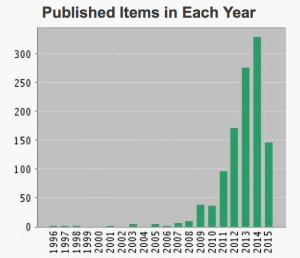Life was comfortable back in 2007. While starting to work on quaternary semiconductors for thin-film solar cells, there was very little literature. It was possible to read all of the papers in the field. Since the report of a 10% efficient solar cell made from Cu2ZnSn(S,Se)4 in 2010, interest in the field exploded and there now stands over 1000 publications. I feel sorry for any new graduate student beginning a project...
Web of Science search for "Kesterite OR CZTS solar cell" with 1155 results - May 2015
From reading quite a few of these papers and attending conferences and workshops over the years, here is a decent reading list to get started:
1. Development of CZTS-based thin film solar cells (Thin Solid Films, 2009) - An important historical overview of the development of the field. Like many technologies, it all started in Japan.
2. New routes to sustainable photovoltaics: evaluation of Cu2ZnSnS4 as an alternative absorber material (Physica Status Solidi B, 2008) - An important paper from Jonathan Scragg (whose PhD thesis turned into the first book on kesterite solar cells) with layers made by electrodeposition.
3. The crystal structure of kesterite type compounds: A neutron and X-ray diffraction study (Solar Energy Materials and Solar Cells, 2011) - X-ray diffraction has trouble distinguishing between Cu and Zn. Neutron diffraction confirms the ground-state crystal structure (not stannite) and the tendency for cation disorder.
4. Kesterite Thin-Film Solar Cells: Advances in Materials Modelling of Cu2ZnSnS4 (Advanced Energy Materials, 2012) - The complexity of these materials has provided a fertile ground for theory and simulation, with early efforts reviewed here on structure, defects and band energies.
5. 8.6% Efficient CZTSSe Solar Cells Sprayed from Water–Ethanol CZTS Colloidal Solutions (Journal of Physical Chemistry Letters, 2014) - simple, clean and easy to scale up, with more recent reports of reproducible 10% efficiency from this approach.
6. Device Characteristics of CZTSSe Thin-Film Solar Cells with 12.6% Efficiency (Advanced Energy Materials, 2014) - The current record device with 12.6% efficiency. The one to beat!
7. Influence of compositionally induced defects on the vibrational properties of device grade Cu2ZnSnSe4 absorbers for kesterite based solar cells (Applied Physics Letters, 2015) - Precision Raman spectroscopy is becoming increasingly useful for identifying secondary phases and quantifying structural disorder in kesterites. The team at IREC are leading the way.
8. Suns-VOC characteristics of high performance kesterite solar cells (Journal of Applied Physics, 2014) - What is limiting performance to less than 20%? This is one of several important detailed charactertisation papers that point to issues with the back contact.
